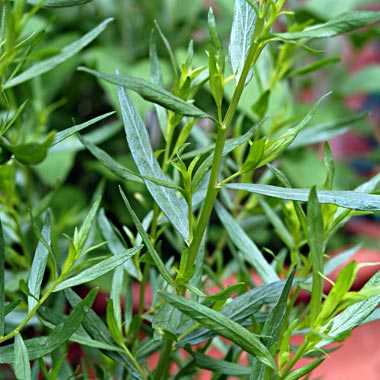French Tarragon
Artemesia dracunculus

French tarragon has very smooth dark green leaves on wiry upright stems,
it dies down entirely in the winter and may not survive if the soil is very wet and cold.
It is therefore best grown in large containers that can be moved to a sheltered spot in winter and kept reasonably dry.
If overwintered in a cold greenhouse new shoots will be appearing by early February.
The chief use of tarragon is in sauces such as Béarnaise and Tartare, and also in the making of flavoured vinegars and oils.
It is also good to use with eggs, chicken, soups, seafood and in rice dishes.
- Place several sprigs of tarragon and some peeled garlic cloves inside a whole chicken before roasting to flavour the meat.
- Add chopped tarragon leaves to rice and pasta salads.
- Chopped tarragon and grated orange zest, added at the end of cooking, to a tomato soup recipe, lifts it out of the ordinary to something really special.
Tarragon Vinegar
Place 8 heaped tablespoons of tarragon leaves
into a pestle and mortar and bruise lightly.
Place in a screw capped jar or wide mouthed bottle and pour over 500 ml white wine or cider vinegar.
Leave in a cool dark place for 2 – 3 weeks whilst the tarragon flavours the vinegar.
Drain the flavoured vinegar off from the leaves and then pour back into the bottle
with a fresh whole sprig of tarragon added for extra flavour and decoration.
Tarragon used to be known as the Dragon Herb, from the Latin dracunculus, and was said to be a cure for poisonous bites and stings. It also stimulates the digestive system.


